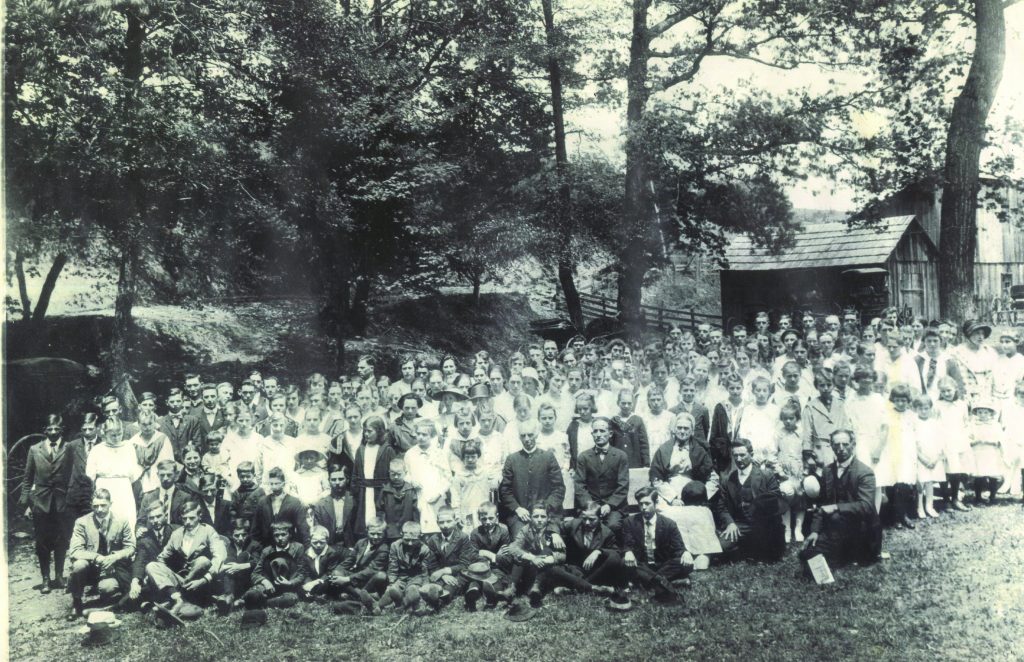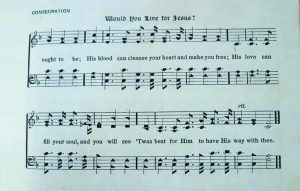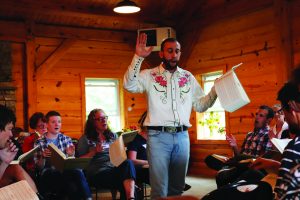
By Sheilah Elwardani
On a cool, damp morning in late August, Sheilah Elwardani of the Floyd County Historical Society found herself following signs with arrows marked simply, ‘Sing’, down increasingly narrow dirt roads, to a farm gate which led across a field and up a hill. Beyond the signs there was nothing to suggest she was doing anything other than trespassing on private property. At the top of the hill, a small barn surrounded by parked cars came into view. She stepped from her car and was immediately carried back in time. She stood for five minutes and simply absorbed the resonating a cappella music rolling strong, clear, and moving from that small building. The Floyd Shape-Note Singers had congregated at this small venue with its excellent acoustics for a full day of traditional, Sacred Harp Shape-Note singing. She was hooked at first note.
Sacred Harp shape-note singing can trace its roots all the way back to Puritan New England during the early 1700’s. The phrase ‘Sacred Harp’ refers to the human voice as the instrument of worship most pleasing to God. Calvinist by theology, the Puritans forbade the use of instruments during worship services.
Early Puritan practices minimized the use of traditional hymns and moved toward a focus on the singing of psalms. The practice of disregarding traditional, sacred hymns became tedious for Puritans during the early 1700’s, leading to a desire to reinvest services with sacred music.
Access to a musical education for the average person in Puritan New England was nearly non-existent. The answer to re-teaching harmony singing to a population with no access to traditional musical instruction was a simplified form of presenting hymns using shapes on the notes to denote how each was to be sung. Sacred Harp shape-note singing was born as a push back against Calvinist minimalism.
Soon after the development of the shape-note system, singing schools emerged, using shape-notes for the purpose of teaching lay-people the foundations of reading music. Singing schoolteachers and composers began to produce new tunes and hymns using the new system, with an adapted four-notes to express the seven-note scale: fa, sol, la, fa, sol, la, mi.
 Eventually, hymnals began to appear using the seven-note system: do, re, mi, fa, so, la, ti. Each hymn began with singing the notes of the entire song prior to beginning the hymn, leading some to affectionately dub these groups ‘the fasola-folk’. Singers were arranged in a square, with the leader standing in the center: altos facing tenors and trebles facing basses. Different parts were often entered at intervals, forging the tune in a manner similar to a round.
Eventually, hymnals began to appear using the seven-note system: do, re, mi, fa, so, la, ti. Each hymn began with singing the notes of the entire song prior to beginning the hymn, leading some to affectionately dub these groups ‘the fasola-folk’. Singers were arranged in a square, with the leader standing in the center: altos facing tenors and trebles facing basses. Different parts were often entered at intervals, forging the tune in a manner similar to a round.
Singing schoolteachers found themselves in demand beyond New England and were soon traveling as circuit riders throughout the Appalachian Mountains. Teachers were commissioned by church congregations to conduct singing schools for children and young adults; often staying within a community for several weeks. The tradition of the singing school survives in Floyd with instruction in shape-note singing continuing to this day. The tradition of Sacred Harp Shape-Note singing is alive and well throughout the Mountain South and has spread across the Atlantic to Ireland, Scotland, Germany, and beyond.
Shape-note singing in Floyd County is vibrant with an active and growing group known simply as the Floyd Shape-Note Singers. The group meets on the second and fourth Tuesday of every month throughout the year, and welcomes anyone who would like to visit or join in the singing.
 The Floyd County Historical Society is paying homage to this traditional music as part of this year’s “Tribute to the Churches of Floyd County”. The current exhibit features Shape-Note hymnals from nearly every denomination in the county. The Floyd County Historical Society will host a public event on Saturday, November 9, 2019 featuring the history of shape-note singing, as well as the Floyd Shape-Note Singers at the Floyd Center for the Arts. The event will begin at 10:00 am with a brief Historical Society meeting followed by guest presenters and shape-note singers. This event is open to the public and the Historical Society invites everyone interested in this traditional music to attend.
The Floyd County Historical Society is paying homage to this traditional music as part of this year’s “Tribute to the Churches of Floyd County”. The current exhibit features Shape-Note hymnals from nearly every denomination in the county. The Floyd County Historical Society will host a public event on Saturday, November 9, 2019 featuring the history of shape-note singing, as well as the Floyd Shape-Note Singers at the Floyd Center for the Arts. The event will begin at 10:00 am with a brief Historical Society meeting followed by guest presenters and shape-note singers. This event is open to the public and the Historical Society invites everyone interested in this traditional music to attend.
For more information about Shape-Note singing, as well as the Tribute to the Churches of Floyd exhibition, please visit the website at: http://www.floydhistoricalsociety.com
For more information about the Floyd Shape-Note Singers, visit their Facebook page at https://www.facebook.com/groups/floydshapenote.
Floyd County Historical Society
217 North Locust Street • (540) 745-3247
www.floydhistoricalsociety.com
Photo Cutlines:
Singing school teachers traveled to Floyd regularly. This singing school photo was taken of the Topeco Church of the Brethren group with their circuit riding teacher in 1918.
Chris Wolf, (leader, organizer and teacher), of the Floyd Shape-Note Singers leads the group in a hymn at an all day singing event on August 24, 2019.
The geometric shapes on the notes denote how each is to be sung. This method is much easier to teach students with no classical music education.
